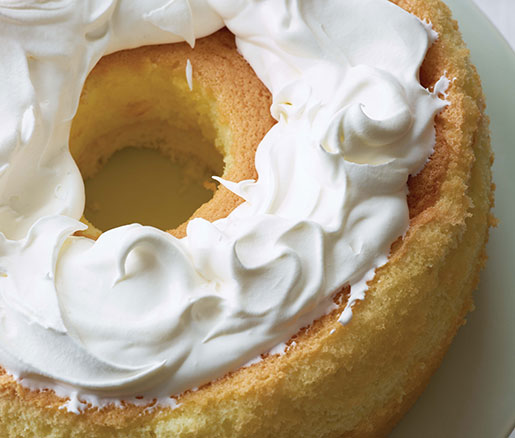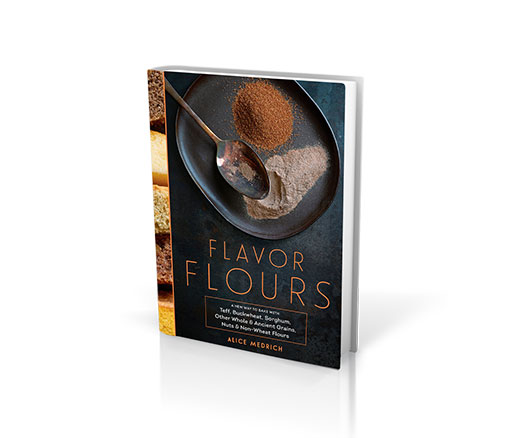
For years flour played an essential but somewhat inconspicuous role in baking, like the foundations of a building. Wheat flour was king, and the main options were “all-purpose” or “bread.” Then came the rise of the gluten-free diet, accompanied by the surge in “alternative” flours. While not new to the market, these products have been game changers for the growing wheat-avoidant ranks and have also helped gluten-free foods overcome their (often undeserved) reputation for being tough and bland bummers.
Thanks to Alice Medrich and her latest book, Flavor Flours, winner of the 2015 JBF Baking and Dessert Book Award, we might be seeing the dawn of yet another new age in baking, one that values the so-called alternatives not for what they lack, but for the unique and full flavors they bring to the larder. “I was excited about working more with “flavor flours,” treating them as “hero” ingredients,” Medrich writes in the book’s introduction. “You will discover, as I have, that these flours and flavors belong in every passionate baker’s repertoire.”

Want to experience the potential of “flavor flours” for yourself? Join us in our first-ever Instagram recipe contest, featuring this Lemon Rice Chiffon Cake (pictured above) straight from the pages of Medrich’s Beard Award–winning cookbook. The recipe is made exclusively with rice flour, which contributes lovely floral and creamy notes to the finished cake. “Rice flour alone is spectacularly delicious in a chiffon cake,” assures Medrich. “You will be amazed.”
What’s more, we’re going to give a copy of Flavor Flours to three lucky participants in the contest. Here’s how to play: bake your own Lemon Rice Chiffon Cake, post a photo of it to Instagram, and tag with #jbfrecipesTK. We’ll repost some of our favorite entries on the James Beard Foundation’s own Instagram page.
A few tips before you get started:
• For equipment, you’ll need a 10-inch tube pan with a removable bottom. You’ll also need a mixer. Medrich uses a stand mixer, but a hand mixer will work just as well.
• The recipe calls for white rice flour or Thai rice flour. Either may be purchased at Asian markets, high-end grocery stores, and even some chain supermarkets—Bob’s Red Mill, a line that’s widely distributed, makes a white rice flour. At the store, you might come across glutinous rice flour (also known as sweet rice flour). Milled from sticky rice, this product shouldn’t be substituted for white rice flour. It’s better suited to baked goods that benefit from some chewiness (such as Medrich’s beignets).
• Medrich recommends pairing the cake with lightly sweetened strawberries or sliced mango or pineapple. Feel free to get creative with your toppings!
We’ll be accepting your gorgeous Lemon Rice Chiffon Cake photos through Friday, July 3. The cake recipe is here and also below. Happy baking!
Lemon Rice Chiffon Cake
Excerpted from Flavor Flours by Alice Medrich (Artisan Books). Copyright © 2014. Photographs by Leigh Beisch.
Yield: 10 to 12 servings
Ingredients:
• 1 cup plus 2 tablespoons (224 grams) sugar
• 5 large egg yolks, at room temperature
• 3/4 cup cool water
• 1/2 cup flavorless vegetable oil (such as rice bran, corn, or safflower oil)
• 1 1/3 cups (200 grams) white rice flour or 2 cups (200 grams) Thai white rice flour
• 2 teaspoons baking powder
• 1 teaspoon salt
• Zest of a medium lemon
• 8 large egg whites, at room temperature
• 1/2 teaspoon cream of tartar
Equipment:
• Stand mixer with whisk attachment
• 10-inch tube pan with removable bottom, ungreased
Method:
Position a rack in the lower third of the oven and preheat the oven to 325°F.
Set aside 1/4 cup (50 grams) of the sugar for later (to stiffen the egg whites).
In a large bowl, combine the remaining sugar, egg yolks, water, oil, rice flour, baking powder, and salt. Whisk until thoroughly blended. Set aside.
In the bowl of the stand mixer, beat the egg whites and cream of tartar with the whisk attachment on medium-high speed until the mixture is creamy white and holds a soft shape. Slowly sprinkle in the reserved sugar, beating on high speed until the egg whites are stiff but not dry. Grate the zest of a medium lemon on top of the batter. Scrape one-quarter of the egg whites onto the batter and use a rubber spatula to fold them in. Fold in the remaining egg whites. Scrape the batter into the pan and spread it evenly.
Bake for 50 to 55 minutes, until the top of the cake is golden brown and a toothpick inserted in the center comes out clean.
Set the pan on a rack. While the cake is still hot, slide a thin knife or spatula around the sides, pressing against the pan to avoid tearing the cake. Leave the cake in the pan to cool—it will settle at least 1 inch.
When cool, lift the tube to remove the cake. Slide a thin knife or skewer around the tube and slide a spatula under the cake all around. Lift the cake off the bottom of the pan using two spatulas (one on either side of the tube) and transfer it to a serving platter. The cake keeps, wrapped airtight, at room temperature for at least 3 days, or in the freezer for up to 3 months; bring to room temperature before serving. Slice with a serrated knife.
Browse and buy all 2015 JBF Book Award winners and nominees in our Amazon store.
Anna Mowry is special projects manager at the James Beard Foundation. Find her on Twitter and Instagram.




-57 web.jpg)


